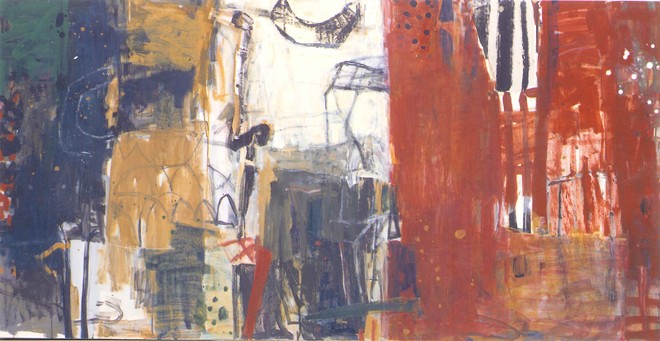

Shireen Kamran’s paintings constitute an inquisitive search into her own psychological makeup and a meditation on coexistence through abstraction. The tensions created by line and colour, harmony and organic form, and the theme of doubling that permeates the exhibition Soul Matters create unexpected echoes of the Surrealists’ efforts to tap into the unconscious and question binary oppositions -- between mind and body, reason and desire.
Were I to try to define these elusive, neurotic images, I would call them ‘mindscapes’ -- renderings of the structure and dynamics of the psyche. Similar in outcome to the famous Surrealist parlour game cadavre exquis (in which a body is assembled on a single page through group authorship) but eschewing the coauthorship and impromptu action characteristic of the game, Kamran’s paintings, in which each fold and reveal the limits of coherence, revel in the dynamic tension at their seams. We can never be sure if these mindscapes are coming together or drawing apart.
Kamran breaks faith with most of her predecessors, and their critics, on the issue of content, asserting the mediation of matters that were often repressed, encoded or sublimated -- gender politics, religion, literature, nature, even metaphor as such. In some cases the ties are explicit, as in Suluk-Wanderings #21, 2014. Usually, though, the connections are made only via title, but in acknowledging the impulse to wrest meaning from abstraction, Kamran underscores the tenacity of this desire.
The exhibition at Canvas Gallery in Karachi offered the chance to consider a single body of Kamran’s production in depth. Executed in Montreal, the works extend the mainstays of her practice in newly buoyant hues of cerulean, emerald and ochre, and in paintings such as Cul de Sac, passages of white aerate these choked compositions. Rue Barree, 2013, is a traffic jam of wet-on-wet vectors that loosen the grid from its axes and assert nothing so much as raw, frontal physicality.
This new work is Kamran’s most abstract yet, and, paradoxically, most her own, revealing her protracted engagement with long-gone masters to have been less an anxiety-of-influence dialogue than a means of liberation.
Shireen Kamran is someone for whom the political and philosophical questions of representation matter -- a critical rather than unambiguously ‘feeling’ type. But vivid, even uncomfortable feelings continue to pull at you, to nag in spectral and parodistic ways. The element of parody does not evacuate emotion; self-conscious feelings are nothing if not acute. Storm and stress, light shattered, no single point of view, nowhere to stand. Nothing could be more perverse than standing in front of one of Kamran’s paintings and maintaining a rigidly stationary pose. The canvases build and recompose themselves with respect to one’s relative position.
A scaffold of caked white calligraphy against an obsidian ground, it affects a hard-won abeyance of line and plane (and, significantly, an attendant pathos), feeling at once exuberant and labored.
Elsewhere, in the show, this conflicted dynamic opened onto other antagonisms endemic to Abstract Expressionism -- intuitive spontaneity versus composition (the tussle between drip and symmetry in The Ocean of the Soul #3), for example, or the grid as self-referential versus the grid as a portal to those regions beyond which it was meant to annul (the inky rectilinear armature of Cul de Sac, 2013, simultaneously forswears illusionist space and creates window like apertures).
Painting hardly needs another revival, although it seems, of late that it is fashionable to speak about such a renewal with force and intelligence. Kamran’s gestures, gouged into argentine surfaces, seem to freeze out a predictably illustrative psychological effect. These works are not lyrically abstract.
Kamran’s relationship with Abstract Expressionism is hard hearted but by no means dead. It’s not just the scraping in her canvases that recalls Gerhard Richter’s work. In fact both of them share ambivalence towards the legacies of abstraction. Richter dwells on the hopelessness of the desire for heroic painting, in the process becoming a heroic figure himself. Kamran, by contrast, worries the impossibility of authenticity in life no less than in painting. Some of the paintings look positively violated. I imagine the artist’s satisfaction in fashioning pictures through deformation: knives dragged through flesh, crusty black blood, marks like bruises, and a startling eruption of foolhardy curlicues.
But then if I see a forest in a particular painting, is it because my reprobate and childishly spooky sensibility insists on seeing tectonic plates, the shifting sharp angles, the tricks of light and a strange dull gold -- the tracks of an elemental nature? I have an image in mind, kind of a Lars von Trier Antichrist image, of a woman kneeling on a perfectly cultivated, mowed lawn, and then reaching into the sod and ripping it apart. Her hands furiously rake the ground.
In Kamran’s painting, the internal contradiction conveys its singularity: there is a relationship between form and content that runs counter to what is usual in Western painting. Instantaneous time of gesture -- "Lightening steers the universe", Hartung used to say, quoting Heraclitus -- makes the work coagulate into the slash of a scar, the wonderment that refuses anything that is not such a sign. By obliterating the surface, Kamran’s brush strokes underline the slow, minutious preparation, the subtle shades that are masked by the breadth of the monochrome field. The slow maturation of a painting is in a certain way the reflection of this inner void, of her self-imposed non-intention before launching into a painting.
Transposing her optical sensations into this pictorial yet insistently palpable format, Kamran invests the familiar environment of her youth with the sensuous and inherently time-bound experience of their original perceptual mapping. Part visually acute reconstruction, part hazy impression recalled through a scrim of memory, each painting on show attested to the inevitably abstract outcome of even the most attentive probing into the landscape of one’s childhood.